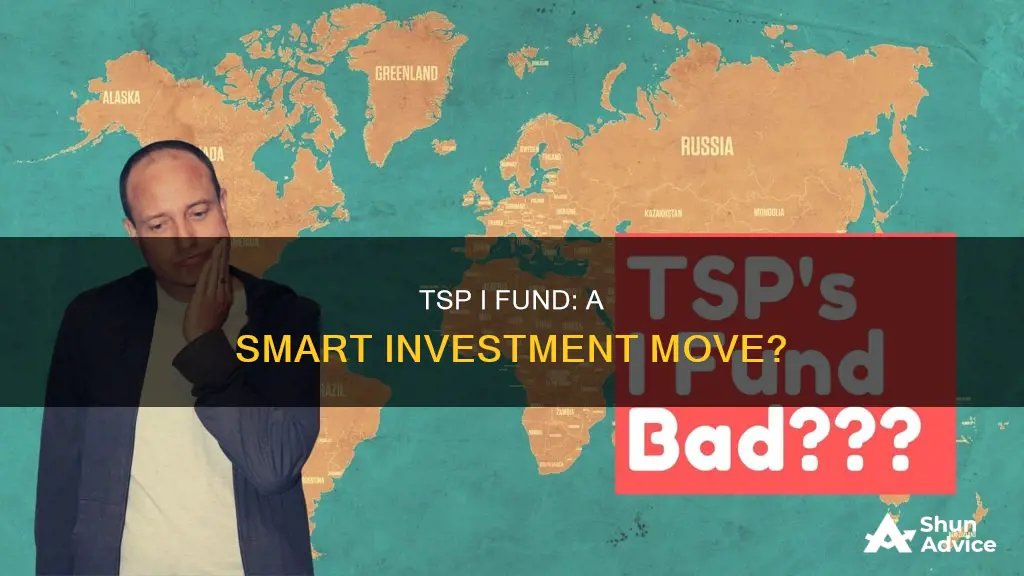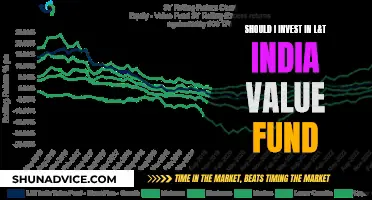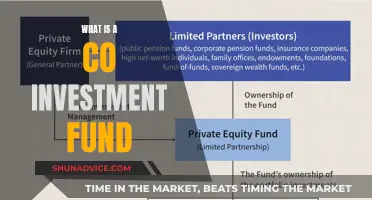
The Thrift Savings Plan (TSP) is a retirement savings and investment plan for federal employees and members of the uniformed service. The TSP's I Fund, focused on developed markets/countries, began to outperform U.S.-based stock funds at the end of 2022. The I Fund is based on the EAFE index of developed countries and has had several breakout years since its inception in the early 2000s. While the fund has experienced fluctuations and faced competition from other stock funds, it has consistently offered investment opportunities with strong long-term growth potential.
Should you invest in the TSP I Fund? This decision depends on your financial goals, risk tolerance, and investment strategy. The I Fund provides international diversification and has the potential to outperform other U.S. stock funds over the long term. However, it's important to consider the fund's performance history, the underlying index it tracks, and how it fits within your overall investment portfolio.
| Characteristics | Values |
|---|---|
| Fund Type | Retirement savings and investment plan for Federal employees and members of the uniformed service |
| Current Benchmark | MSCI Europe, Australasia and Far East (MSCI EAFE) Index |
| Future Benchmark | MSCI All Country World Investable Market Index ex USA ex China ex Hong Kong (MSCI ACWI IMI ex USA ex China ex Hong Kong) Index |
| Number of Countries | 21 developed countries |
| Number of Companies | About 800 large- and medium-capitalization companies |
| Fund Performance | The I Fund outperformed the C and S Funds in November and December 2022 |
| Dividend Payout | The I Fund had three times the dividend payout of the C Fund and four times the dividend payout of the S Fund as of early January 2023 |
What You'll Learn

The I Fund's historical performance
The TSP I Fund (International Stock Index Investment Fund) is an international stock index fund that tracks the investment performance of the Morgan Stanley Capital International ACWI IMI ex USA ex China ex Hong Kong Index.
As of 18 October 2024, the fund has a compound annual growth rate of 6.0%, an annualised standard deviation of 17.6%, and a Sharpe Ratio of 0.18. An initial investment of $1,000 on 31 August 1990 would be worth $7,217 as of 18 October 2024. The worst drawdown since inception was -60.9%.
The I Fund's performance in the early 2000s was impressive, outperforming the C Fund by a large margin. At its peak in late 2007, the I Fund was 20% higher than the S Fund and over 40% higher than the C Fund. However, since 2007, the EAFE index, which the I Fund is based on, has stagnated. The I Fund dropped by over half to $34.68 in February 2009, mirroring most other stock indices worldwide.
Despite the I Fund's lacklustre performance in recent years, it has grown to over $36 a share as of early February 2023 from $10 at its inception in mid-2003. This growth is half that of the C and S Funds but double that of the bond-tracking G and F Funds.
The I Fund's benchmark index changed in 2024, further diversifying its investments and giving TSP participants access to more markets and companies. The new index is expected to offer opportunities for higher returns without significantly increasing risk.
KiwiSaver Investment Funds: Where Does Your Money Go?
You may want to see also

The I Fund's future outlook
Firstly, the I Fund is undergoing a benchmark index change in 2024, which will further diversify its investments. This change will provide access to more markets and companies, potentially leading to higher returns without a significant increase in risk. The new index, the MSCI All Country World Investable Market Index ex USA ex China ex Hong Kong, will offer exposure to a broader range of companies and countries, enhancing the fund's diversification.
Secondly, the I Fund provides an opportunity to invest in non-US companies, specifically in more than 40 developed and emerging market countries. This international diversification can reduce exposure to market risk and is an excellent way to diversify a stock portfolio.
Thirdly, the I Fund has historically outperformed US-based stock funds at times. For example, in late 2007, the I Fund was 20% higher than the S Fund and over 40% higher than the C Fund. While the fund has underperformed in recent years, leading to a decrease in allocations, it has the potential to outperform other funds again in the future.
Additionally, the I Fund has a better dividend payout than the C or S Funds, offering three to four times the dividend payout as of early 2023. This higher dividend payout enhances its attractiveness as an investment option.
Lastly, the I Fund could benefit from positive global events, such as the world moving on from COVID-19 outbreaks and the potential for economic growth and tourism boosts from events like the 2024 Summer Olympics in France.
However, it is important to note that there are also factors that could weigh on the fund's returns, including aging and declining populations, high debt ratios, and prolonged global instability. Nonetheless, the I Fund presents an opportunity for investors to further diversify their portfolios and gain exposure to international markets, which could be advantageous in the long term.
Index Fund Investing: A Guide for Ireland-Based Investors
You may want to see also

The I Fund vs. other funds
The I Fund is an international stock index investment fund that offers investors the opportunity to gain exposure to equity ownership of non-US companies. It is one of the five core funds available in the Thrift Savings Plan (TSP) offered to US government employees.
The I Fund vs. Other TSP Funds
The I Fund is the only TSP fund that invests in companies outside the US. It is also regarded as one of the two high-risk funds in the TSP, along with the S Fund. The I Fund has historically posted a higher average annual return than the C Fund, which is the most conservative of the three stock funds available in the TSP.
The I Fund is based on the MSCI Europe, Australasia, and Far East (MSCI EAFE) Index, which invests in larger, more established companies located in 21 developed countries. However, the I Fund does not include Canada, emerging markets, or small companies, which may be a disadvantage compared to other funds.
One alternative to the I Fund within the TSP is the S Fund, which holds securities in the Dow Jones U.S. Completion Total Stock Market Index. This index is composed of over 4,000 smaller and less established companies than the S&P 500, giving them greater potential for growth.
Another option is the C Fund, which is a more conservative stock fund that invests in the 500 large and mid-cap companies that comprise the Standard and Poor's 500 Index. This fund has experienced greater volatility than the G or F Funds, which are bond funds, but has posted higher returns over time.
Outside of the TSP, investors can consider international index funds offered by other financial institutions, such as the iShares MSCI EAFE ETF (EFA) by BlackRock, which is based on the same index as the I Fund.
The I Fund vs. Other International Funds
When comparing the I Fund to other international funds, it is important to consider the index that the fund is based on, the fees associated with the fund, and the level of diversification offered.
The I Fund is based on the MSCI EAFE Index, which invests in larger, more established companies in 21 developed countries. Other international funds may be based on different indexes that include a broader range of countries or focus on specific regions or emerging markets.
The I Fund has a total expense ratio of 0.054%, which is relatively low compared to other funds. However, there may be other international funds with lower fees, so it is important to compare the costs of different funds before investing.
In terms of diversification, the I Fund provides exposure to a range of developed and emerging market countries, excluding the US. However, it does not include Canada or small companies, which may be a limitation compared to other international funds.
Overall, the I Fund can be a good option for investors seeking exposure to international stocks, particularly those invested in the TSP. However, it is important to consider the alternatives within the TSP and the range of international funds offered by other financial institutions to find the best fit for your investment goals and risk tolerance.
Mutual Funds: Profitable Investment or Risky Business?
You may want to see also

The I Fund's diversification benefits
The I Funds Diversification Benefits
The I Fund, based on the EAFE index of developed countries, offers investors a way to diversify their portfolios and reduce risk. Diversification is a crucial investment strategy that allows investors to lower their portfolio's risk and achieve more stable returns. By investing in a range of asset classes and across different sectors, investors can protect themselves from major losses if one business or sector fails or performs poorly.
The I Fund provides access to international markets and companies, specifically in Europe, Australasia, and the Far East. This diversification offers several benefits:
Access to Developed Markets:
The I Fund focuses on developed markets, which can provide more stability and lower risk compared to emerging markets. These countries have more established and mature economies, reducing the potential for volatility associated with emerging markets.
Geographic Diversification:
By investing in the I Fund, individuals gain exposure to international markets beyond just the US. Geographic diversification is an important aspect of portfolio construction, as it allows investors to access different economic and market conditions in various regions. This helps protect against country-specific or regional risks and can provide a hedge against domestic market downturns.
Broader Investment Opportunities:
The I Fund's underlying index includes a diverse range of large- and medium-capitalization companies across 21 developed countries. This breadth of investment opportunities provides access to a wider range of sectors and industries, reducing the concentration risk associated with investing solely in US companies.
Enhanced Portfolio Resilience:
Diversification is a key strategy for building resilience into an investment portfolio. By investing in the I Fund, individuals can lower their overall investment risk. If US markets experience a downturn, international markets may still provide positive returns, thus offsetting potential losses in domestic investments.
Long-Term Growth Potential:
While short-term performance can vary, the I Fund has the potential for long-term growth. Historical data shows that the I Fund has had breakout years and has outperformed US-based stock funds at times. By including international markets in their portfolios, investors can benefit from the growth and performance of companies outside the US.
In summary, the I Fund offers investors a valuable tool for diversifying their portfolios and reducing risk. By investing in international markets and developed countries, individuals can access a broader range of investment opportunities and enhance the resilience of their portfolios over the long term.
A Guide to Index Fund Investment Strategies
You may want to see also

The I Fund's accessibility
The Thrift Savings Plan (TSP) is a direct-contribution retirement plan offered to US government employees. It offers five core mutual funds to invest in, four of which are diversified index funds. The International Stock Index Investment Fund (I Fund) is one of the broader international indexes, investing in larger, more established companies located in 21 developed countries around the world.
The I Fund is accessible to all TSP participants and is a very low-cost way to gain diversified exposure to the international stock market. It has an annual expense ratio of 0.054%. The fund is passively managed and remains fully invested during all market cycles and economic conditions.
The I Fund's benchmark index changed in 2024 to further diversify investments and give TSP participants access to more markets and companies. The new index is the MSCI All Country World Investable Market Index ex USA ex China ex Hong Kong (MSCI ACWI IMI ex USA ex China ex Hong Kong) Index. This index includes more than 5,000 large-, medium-, and small-capitalization companies in 23 emerging market countries.
During the transition to the new benchmark index, TSP fund managers will need to sell some stocks and buy others. This will be done over several months to minimize costs and protect the fund from potential unfair trading advantages for other investors. The transition will be complete by December 31, 2024.
Throughout this transition, TSP participants will continue to have access to the I Fund. Money invested in the I Fund will remain invested unless the participant chooses to change their investments. Participants can move money into and out of the I Fund by requesting a reallocation, fund transfer, or change to their investment election. Withdrawals and loans from accounts with I Fund investments will include a proportional amount from those investments.
Pension Funds and Hedge Funds: A Match Made in Heaven?
You may want to see also
Frequently asked questions
The TSP I Fund is the Thrift Savings Plan's international or "I" fund, which focuses on developed markets/countries.
The TSP I Fund has had a mixed performance history. While it had several breakout years when it first opened in the early 2000s, it has since underperformed compared to other funds. However, in recent years, it has started to outperform U.S.-based stock funds.
Investing in the TSP I Fund can provide international diversification to your portfolio. It offers access to developed markets and companies in Europe, Australasia, and the Far East. Additionally, the fund is expected to transition to a new benchmark index in 2024, which will further diversify investments and provide access to more markets and companies.
The TSP I Fund has historically underperformed compared to other funds, and it does not include emerging markets, small companies, or investments in certain countries like Canada. There are also concerns about market volatility and potential exposure to unethical and harmful companies in some countries.
The decision to invest in the TSP I Fund depends on your risk tolerance, investment goals, and time horizon until retirement. It is essential to consider the benefits of diversification and weigh them against the fund's historical performance and potential risks. Consulting with a financial advisor can help you make an informed decision based on your specific circumstances.







